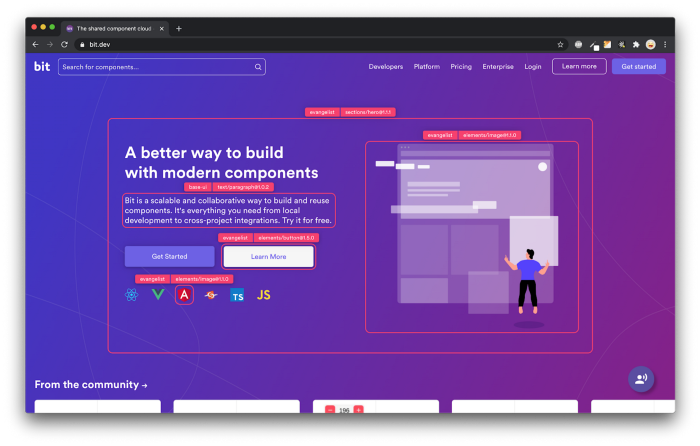This content originally appeared on Bits and Pieces - Medium and was authored by Vivek Rajyaguru

Angular is a popular front-end framework used for developing single-page applications (SPAs). It has a modular architecture and provides a lot of tools and features to make the development process easier and more efficient. One of the key aspects of developing a successful Angular application is scalability. In this blog, we will explore some techniques for building scalable applications using Angular.
Use Lazy Loading
Lazy loading is a technique used to load modules only when they are required. This can help reduce the initial loading time of the application and improve its performance. In Angular, you can use the loadChildren property to lazy load modules.
Here is an example:
const routes: Routes = [
{ path: '', component: HomeComponent },
{ path: 'lazy', loadChildren: './lazy/lazy.module#LazyModule' }
];
Use a Modular Architecture
The modular architecture is an important aspect of building scalable applications. In Angular, you can use modules to organize your application into smaller, more manageable pieces. This can help improve the maintainability of the code and make it easier to add new features.
💡 This is exactly the approach an open-source toolchain like Bit enables. By adopting a composable, modularity-first design for your components, and independently storing, testing, and documenting atomic units of UI instead of entire apps at once, your app scales better, and is infinitely more maintainable. This guide will show you how.
Here is an example of a module:
@NgModule({
declarations: [AppComponent],
imports: [BrowserModule, AppRoutingModule, SharedModule],
providers: [],
bootstrap: [AppComponent]
})
export class AppModule { }Use a State Management Library
As your application grows, managing the state can become more difficult. One way to simplify this process is by using a state management library, such as NgRx or Akita. These libraries provide tools for managing the state of your application and can help you build more scalable and maintainable code.
Here is an example of using NgRx:
export interface AppState {
counter: number;
}
export const initialState: AppState = {
counter: 0
};
export function reducer(state = initialState, action: Action): AppState {
switch (action.type) {
case INCREMENT:
return { ...state, counter: state.counter + 1 };
case DECREMENT:
return { ...state, counter: state.counter - 1 };
default:
return state;
}
}Use Reactive Forms
Reactive forms are a powerful tool for building scalable and maintainable forms in Angular. They provide a declarative approach to form validation and can help you build complex forms with less code.
Here is an example of using reactive forms:
export class LoginComponent implements OnInit {
loginForm = this.fb.group({
email: ['', [Validators.required, Validators.email]],
password: ['', [Validators.required, Validators.minLength(6)]]
});
constructor(private fb: FormBuilder) {}
ngOnInit(): void {}
onSubmit() {
console.log(this.loginForm.value);
}
}Use Component-based Architecture
Component-based architecture is a key aspect of building scalable applications in Angular. It allows you to break your application into smaller, reusable components, which can be combined to build more complex features.
💡 This is once again where Bit can help. You can use Bit to “harvest” Angular components from any codebase and share them on bit.dev. You can learn more about this here.
Here is an example of a component:
@Component({
selector: 'app-header',
template: `
<nav>
<ul>
<li><a routerLink="/">Home</a></li>
<li><a routerLink="/about">About</a></li>
</ul>
</nav>
`
})
export class HeaderComponent {}In conclusion, building a scalable application using Angular requires a combination of techniques and best practices. By using lazy loading, modular architecture, state management libraries, reactive forms, and component-based architecture, you can build more maintainable, performant, and scalable applications.
Build Angular Apps with reusable components, just like Lego

Bit’s open-source tool help 250,000+ devs to build apps with components.
Turn any UI, feature, or page into a reusable component — and share it across your applications. It’s easier to collaborate and build faster.
Split apps into components to make app development easier, and enjoy the best experience for the workflows you want:
→ Micro-Frontends
→ Design System
→ Code-Sharing and reuse
→ Monorepo
Learn more:
- How We Build Micro Frontends
- How we Build a Component Design System
- How to reuse React components across your projects
- 5 Ways to Build a React Monorepo
- How to Create a Composable React App with Bit
Best Practices for Building Your Angular Apps was originally published in Bits and Pieces on Medium, where people are continuing the conversation by highlighting and responding to this story.
This content originally appeared on Bits and Pieces - Medium and was authored by Vivek Rajyaguru
Vivek Rajyaguru | Sciencx (2023-03-20T06:14:45+00:00) Best Practices for Building Your Angular Apps. Retrieved from https://www.scien.cx/2023/03/20/best-practices-for-building-your-angular-apps/
Please log in to upload a file.
There are no updates yet.
Click the Upload button above to add an update.
